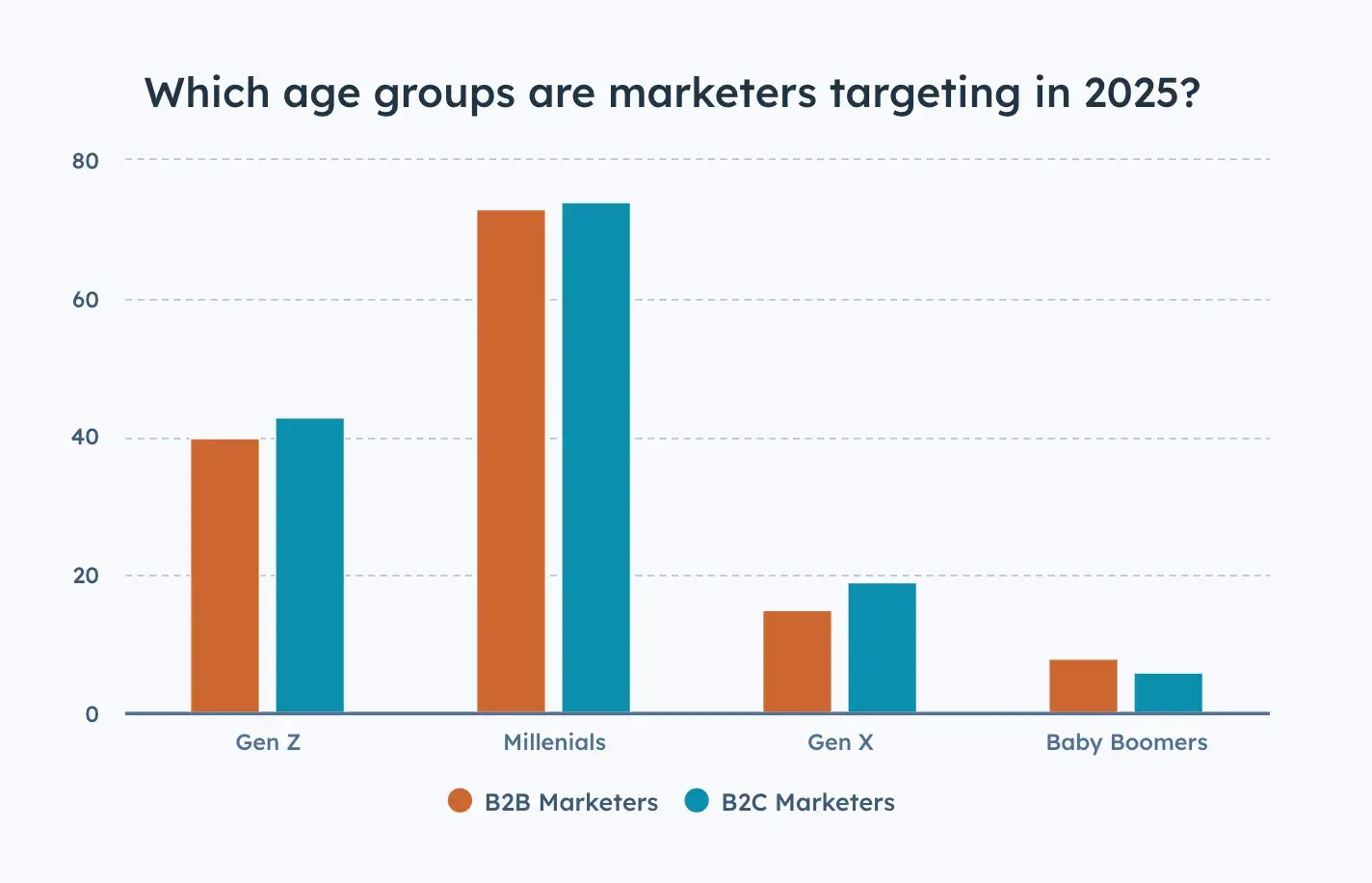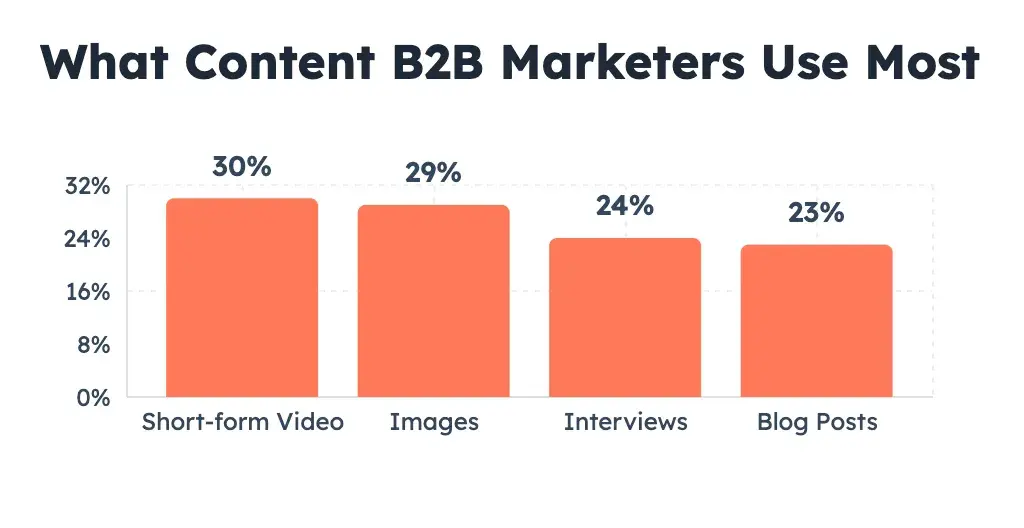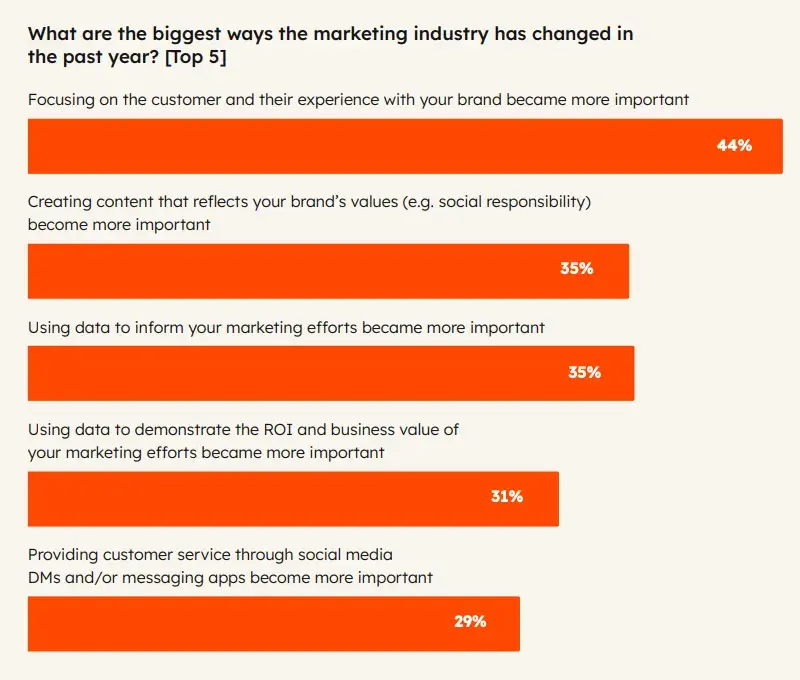Below, I’ll share the top marketing channels identified in that survey. I’ll also discuss how these channels can help amplify your reach and how real marketers are planning to implement them into their 2025 strategies.
Table of Contents
- Top B2B Marketing Channels
- Top B2C Marketing Channels
- Social Media Marketing
- Video Marketing
- Influencer Marketing
- Search Engine Optimization
- Podcast Marketing
- My Takeaways on the Top Marketing Channels
Top B2B Marketing Channels
Before I dive into the channels marketers are focusing on, I want to highlight who they’re marketing to.
Over 70% of B2B and B2C marketers plan to target Millennials in 2025, followed by Gen Z at over 30%. Meanwhile, marketers’ interest in reaching Gen X and Baby Boomer audiences is down 30%.

When it comes to how marketers plan to reach these decision-makers, our survey found that the channels seeing increased investment in 2025 are:
- Brand awareness.
- Website/blog/SEO.
- Paid social media content.
- Organic social media content.
- Video marketing.
Of marketers, 92% plan to maintain or increase investments in brand awareness in 2025, making it the top marketing channel across the board. Additionally, 13% of marketers plan to invest in brand awareness for the first time in 2025.
Brand-led marketing campaigns are becoming a top priority as consumers seek authenticity. Marketers plan to use brand-led campaigns to communicate their brand values, such as social responsibility.
I’m not surprised by this response, given that 65% of marketers reported that addressing social issues in marketing campaigns in 2024 was effective for their brand.
The top B2B marketing channels that resulted in the best ROI in 2024 were:
- Website, blog, and SEO.
- Paid social media content.
- Social media shopping tools.
In my opinion, one of the most interesting findings from the HubSpot survey is that both B2B and B2C marketers are leveraging visual content over text-heavy content.
As a B2B marketer and writer, I’m personally drawn to text content like blog posts. But I can’t deny the impact of visual storytelling. Attention these days is limited, so it makes sense for both business-facing and consumer-facing businesses to use strong visuals to grab their audience’s attention.
The content formats that B2B marketers are using most are short-form video (30%) and images (29%), followed by interviews (24%) and blog posts (23%).

With increasing content needs, especially on the visual side, marketers are turning to AI tools to help them generate more content. One in four marketers plan to leverage using AI to turn text into multimedia campaigns.
Moreover, the survey found that there’s still a learning curve that comes with AI for B2B and B2C marketers alike. Marketers are reporting that they feel overwhelmed by the idea of incorporating AI into their marketing strategies and workflows, with less than half saying they have a clear understanding of how to use AI in their marketing strategy.
When it comes to social media channels, the data shows that LinkedIn is a more important platform for B2B brands than B2C, with B2B marketers substantially more likely to report investing in this platform.
Finally, the top marketing strategies that B2B marketers are turning to in 2025 are:
- Using AI to turn text into multimedia campaigns.
- Using AI-powered reporting tools to evaluate the ROI of campaigns.
- Automating marketing strategy and execution with AI.
- Creating content that reflects your brand’s values.
- Personality-led content, creators, and authentic engagement.
Top B2C Marketing Channels
Many B2C marketers use platforms similar to their B2B counterparts but with a few key differences. For B2C brands, the top marketing channels with the best ROI in 2024 were:
- Email marketing
- Paid social media content
- Content marketing
Like B2B, the top content format for B2C marketing was short-form video. Of B2C marketers, 30% say they use short-form video as part of their content strategy. Compared to B2B marketers, B2C marketers incorporated more user-generated content (UGC) and live streaming in their content.
B2C marketers are also prioritizing authenticity in their marketing in 2025 and will likely use social media channels to do so.
HubSpot’s survey offered further support for the importance of social media, finding that B2C brands are planning to invest in Facebook, Instagram, YouTube, and TikTok in 2025.
Finally, the top B2C marketing strategies for 2025 are:
- User-generated content.
- Creating content that reflects your brand’s values.
- Leveraging AI to turn text into multimedia campaigns.
- Using social media DMs (direct messages) for customer service.
- Using AI-powered reporting tools to evaluate the ROI of campaigns.

Social Media Marketing
In 2025, I expect to see the rise of visual social media content driven by compelling storytelling.
The HubSpot survey found that consumers are looking for even more authenticity than ever before, and I think marketers will meet that expectation with brand-led social content and increased partnerships with content creators.
In fact, marketing leaders are prioritizing hiring for social media, creative, and content roles in 2025.
The top marketing role that leaders are making a recruiting priority in 2025 is a social media coordinator. Other top-priority roles include a content creator and social media strategist.
According to HubSpot’s survey of marketing professionals, the top performing content format in 2024 was short-form video. This points to the impact of social media — one that will continue to grow in 2025.
The top social channels for 2025 are YouTube, Instagram, and TikTok. These channels make sense to me given that they all offer opportunities for short-form video.
Video Marketing
Now is the time if you’ve yet to invest in video marketing.
Across industries and markets, I’ve found that video can be a great way to boost conversions, improve ROI, reach new audiences, and help you build relationships with current customers.
That may be why marketers report that video is the top media format they leverage today.
That being said, there are a lot of different kinds of videos. Regarding marketing, short-form content takes the cake for both B2B and B2C marketers.
21% of marketers say that short-form video delivers the highest ROI compared to other visual content formats.
Interestingly, the marketing channels seeing increased investment in 2025 are YouTube (30%), followed by Instagram (29%), and TikTok (28%). All three channels allow marketers to exercise their short-form video skills, so it makes sense that they’re focusing their time and resources there in the year to come.
I was curious why marketers believe short-form video is effective, and Jay Kallman, Founder of Revvy Marketing, describes it like this:
“Let’s be honest, attention spans are short, and consumers respond to the kind of stimulus that feels personal and relatable,” she says. “People want to feel seen and understood, and short-form video is engaging, real, and proven to work.”
Going into 2025, Kallman plans to lean further into short-form video to build awareness, trust, and authentic connections.
“You’ll see us showing up on platforms like LinkedIn in ways that feel approachable and real,” she says. “We’re also encouraging our clients to ditch overly polished videos — consumers don’t need ‘perfect,’ they need authentic.”
Influencer Marketing
Both B2B and B2C marketers found success with influencer marketing in 2024, telling me that this will continue to be a top marketing channel in 2025.
Marketers report seeing the highest ROI from influencers on the following social channels:
- Facebook (28%).
- Instagram (22%).
- YouTube (12%).
As far as spending goes, brands spent anywhere from 50-74% of their marketing budget on influencers or content creators.
Our survey also found that marketers found the most success with micro-influencers — those with audiences in the range of 10K-100K followers.
In my experience, micro and even nano influencers have the most impact on their audiences. Niche influencers and content creators have built a lot of trust within their tight-knit community, so any brand they partner with automatically gains more credibility.
This is especially important as research has shown that consumers today gravitate towards authenticity. This means they tend to shy away from traditional lead-generating content, instead turning to influencers for product recommendations.
I asked Nicole Ponce Sanchez, Influencer Marketing Team Lead at Semrush, how influencer marketing is affecting the B2B space.
“The Martech influencer space is changing, and the reality of the landscape is that both consumers and brands are getting smarter,” she says. “Brands are now looking for influencers who create engaging, meaningful content that drives real results — not just entertainment for the sake of it.”
She adds, “In 2025, marketers will focus on authentic storytelling and building communities. We’re seeing a big rise in nano-influencers, which makes sense as they’re often more affordable and have deeper connections with their audiences.”
Kallman offered a similar sentiment when I asked about using influencer marketing as a channel:
“For 2025, I’d say lean into niche and local influencers who align with your brand values,” she says. “They can help build trust, foster connections, and expose your brand to the right people. At the end of the day, trust is going to be what wins in 2025, and micro-influencers are the perfect bridge to get there.”
Search Engine Optimization
Another critical component of any modern marketer’s strategy is Search Engine Optimization or SEO marketing.
If you successfully optimize your web content, it will position your brand as an authority in your domain, ultimately helping you increase organic traffic and your conversion rate.
It’s important to note that SEO isn’t just about your website. All of your web content needs to be search engine optimized.
That includes your YouTube channels, Google business profile, and podcast episodes, which should be optimized using target keywords.
And I’ll go ahead and point out what you’re probably thinking: yes, AI is changing the way people search for content online — but it’s not yet a bad thing for marketers.
Nearly half of both B2B and B2C marketers report their web traffic has increased as a result of consumers using AI for search.
Additionally, HubSpot’s survey found that 15% of marketers are increasing their investment in SEO in 2025, and 19% plan to build an SEO strategy for generative AI in search.
Case in point: Ksenia Busheva, Co-Founder and CMO at Pronounce AI, shared with me that in 2025, her team plans on investing in creating high-quality website and blog content to drive organic traffic — a strategy that’s proven to work well for the startup.
“In 2025, our organic traffic strategy is becoming even more interesting,” says Busheva. “Now, we’re not just competing with other websites for Google search rankings, but we also need to optimize for AI search results.”
She adds, “We’re optimizing our website and blog for the Bing search engine, as this can help us appear as a source on ChatGPT. To effectively rank in AI search results, we’re updating old articles, implementing better data markups, and adding FAQ/QA blocks. The SEO game is changing, and now is a great time to implement new strategies.”
Podcast Marketing
In 2024, podcast listening reached an all-time high. Research by Edison found that 100 million Americans listen to podcasts weekly.
Audio content is in high demand, so for many brands, podcasts can be a great platform to reach larger audiences.
The HubSpot survey found that 91% of marketers plan to maintain or increase their investments in podcasts and audio content in 2025.
It’s easy to see the appeal of podcasts, especially for a business. Podcast hosts help demonstrate the human side of your business while also serving as brand-specific influencers.
In addition, because people can listen to podcasts passively while doing other things, this can be an excellent channel for reaching people during their morning commutes, walking their dogs, or cleaning the house.
Featured Resource: How To Start a Podcast For Your Business
Podcasts can also be compelling because the human brain is programmed to crave, seek out, and respond to a well-crafted story.
The audio medium can be an excellent opportunity to tell a compelling story, capturing your audience’s attention while making your brand more personable.
My Takeaways on the Top Marketing Channels
Based on what worked for marketers in 2024, I expect the 2025 trends to build naturally on those strategies.
The more consumers are exposed to marketing, the less they trust it. It makes sense to me why authenticity has been becoming more of a priority in recent years. In 2025, I think authentic, creator content will drive marketing strategies across B2B and B2C industries.
Another takeaway is that visual content is here to stay. Short-form videos exploded in 2024, with TikTok and Reels leading the way and YouTube Shorts falling close behind.
There’s no shortage of video content, which means marketers must now focus on getting attention from their audience. In my experience, this is no small feat. But with the help of influencers, a strong brand POV, and the use of AI tools, marketers can find success.
Different marketing channels come with different benefits, but most businesses can find a way to use different channels in their marketing strategies to meet their unique business goals.
Using a range of different marketing channels can be a great way to create those multiple points of contact, nurture your leads over time, increase conversions, and help you achieve your marketing goals.
Editor's Note: This post was originally published in April 2019 and has been updated for comprehensiveness.
Marketing Strategy







![The state of inclusive marketing in 2025 [new data + expert insight]](https://53.fs1.hubspotusercontent-na1.net/hubfs/53/inclusive-marketing-report.webp)
![How marketers are navigating a possible recession (and advice about what you should do during it) [new data]](https://53.fs1.hubspotusercontent-na1.net/hubfs/53/image12-May-27-2025-02-18-19-8390-AM.png)



![Cultural Marketing: What It Is & How to Do It The Right Way [According to Experts]](https://53.fs1.hubspotusercontent-na1.net/hubfs/53/Untitled%20design%20-%202025-04-03T163531.949.jpg)